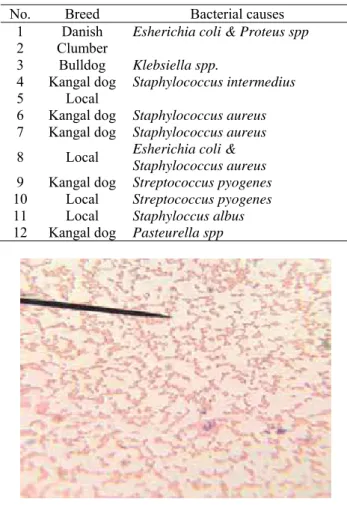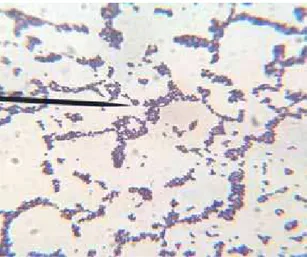Iraqi Journal of Veterinary Sciences, Vol. 28, No. 1, 2014 (27-29)
27
Isolation of the bacterial causes of tonsillitis in dogs
B. Al-Mufti
Department of Veterinary Clinical Sciences, College of Veterinary Medicine, University of Duhok, Duhok, Iraq
(Received October 8, 2013; Accepted November 11, 2013)
Abstract
The study was performed to identify the bacterial causes of tonsillitis in dogs. Twelve clinical cases of dogs (5 males and 7 females) of different ages and breeds were observed. Tonsils swabs were taken from all the dogs, then cultured on different agars and bacterial smears prepared from all cultures and Gram stains were done. The study confirmed that the most bacterial causes of tonsillitis in dogs were Escherichia coli, Staphylococcus aureus, Staphylococcus intermedius, Staphylococcus albus,
Streptococcus pyogenes, Klebsiella spp. and Pasteurella spp.
Keywords: Bacterial causes; Tonsillitis; Dogs Available online at http://www.vetmedmosul.org/ijvs
ببس لا
ىلع
ف عتلا
لاكلا
يف
نيت وللا
ھتللا
يموث جلا
يتف لا
ميھا با
ھ ب
ي طيبلا
ي ي سلا
و علا
ف
،
ي طيبلا
بطلا
ي ك
،
كوھ
عم ج
ا علا
،كوھ
،
صلاخلا
تممص
ببسملا
ف عمل
سا لا
ھ
كوھ
ف حم
ا علا
يف
لاكلا
يف
نيت و لا
ھ للا
يموث جلا
.
نم
شع
ثا
تم سا
)
لاكلا
نم
يض ملا
لا حلا
٥
و
وك
٧
م
اوناو
معا
ا و
(
نا
.
يف
تع و
لا حلا
لك
نم
نيت و لا
نم
حسم
خا
حسم
ھ م
خاو
م
يع
ط سوا
ب ھ للاا
ھ
ببسم
صي ش ل
تغبصو
.
لا
ب صا
ت بثا
سا لا
ھ
لاكلا
يف
و
ببسمل ب
يل لا
:
Escherichia coli, Staphylococcus aureus, Staphylococcus intermedius, Staphylococcus albus, Streptococcuspyogenes, Klebsiella spp. and Pasteurella spp.
Introduction
Tonsillitis is common in pet animals like dogs, it occurs as a primary disease (1), and it could occurs secondary to nasal, oral, or pharyngeal disorders, chronic vomiting, regurgitation or chronic coughing (2). Chronic tonsillitis in young dogs is thought to represent maturation of pharyngeal defense mechanisms (1,2). The most pathogenic bacteria that isolate from diseased tonsils are Escherichia coli, Staphylococcus aureus, and hemolyticstreptococci (1-3).
Fever and malaise are uncommon unless consequent to systemic infection (1) Gagging, followed by retching and soft cough, may result in expulsion of small amounts of mucus (1,3). In appetence, listlessness, salivation, and
Iraqi Journal of Veterinary Sciences, Vol. 28, No. 1, 2014 (27-29)
28
Materials and methods
Twelve dogs (5 males and 7 females) of different ages and breeds were sued in this study for the period from January 2011 till may 2013, as shown in Table 1.
Table 1. Shows the numbers of cases, their sex, ages and breeds
No. Sex Age (Year) Breed
1 Male 6 Danish
2 Female 8 Clumber
3 Female 8 Bulldog
4 Male 9 Kangal dog
5 Female 9 Local
6 Female 3.5 Kangal dog
7 Male 11 Kangal dog
8 Female 4 Local
9 Female 1 Kangal dog
10 Female 0.5 Local
11 Male 1 Local
12 Male 8 months Kangal dog
All the diseased dogs were completely clinically examined at the clinic of faculty Veterinary Medicine – Duhok University; they had been suffering from different health problems like oral and nasal disorder, vomiting and coughing. All clinical examination parameters used to diagnose these cases. Tonsils swabs taken from all the diseased dogs, some of them under sedation and some under effect of general anesthesia. Some swaps then cultured on the MacConkey agar and blood agar, while some swaps cultured on the Blood Agar, Mannitol Salt Agar and Nutrient Agar. Bacterial smears prepared from all the cultures. Gram stains and most biochemical tests like Mannitol Salt Agar, Blood agar Plates, Coagulase Test, MacConkey agar and Indole test (8,9) used to identify the causes of these tonsil inflammation.
Results
All the tonsils swabs from all the diseased dogs showed different infections as a source of the inflammation of tonsillitis in these dogs, except the cases No. 2 and 5 were the samples destroyed. The different microorganisms which were diagnosed through the bacteriological examinations were appeared in Table 2. Figures 1-4 show microscopic appearance of some of these microorganisms.
Table 2. Show the result of the bacterial causes of the Tonsillitis
No. Breed Bacterial causes
1 Danish Esherichia coli & Proteus spp
2 Clumber
3 Bulldog Klebsiella spp.
4 Kangal dog Staphylococcus intermedius
5 Local
6 Kangal dog Staphylococcus aureus
7 Kangal dog Staphylococcus aureus
8 Local Esherichia coli &
Staphylococcus aureus
9 Kangal dog Streptococcus pyogenes
10 Local Streptococcus pyogenes
11 Local Staphyloccus albus
12 Kangal dog Pasteurella spp
Fig. 1: Infection with Pasteurella spp with Gram stain. (100X).
Iraqi Journal of Veterinary Sciences, Vol. 28, No. 1, 2014 (27-29)
29
Fig. 3: Infection with Staphylococcus albus Gram stain. (100X).
Fig. 4: Infection with Streptococcus pyogenes Gram stain. (100X).
Discussion
For the first time in Iraq the identification of the bacterial causes of tonsillitis in dogs was done and
performed through this study. The study confirmed that the most bacterial causes of tonsillitis in dogs were Escherichia coli, Staphylococcus aureus, Staphylococcus intermedius, Staphylococcus albus, Streptococcus pyogenes, Klebsiella spp. and Pasteurella spp. These findings agreed with the results of other studies (2,4,5). During the review of the literatures we did not find any confirmation that the
Staphyloccus albus and Pasteurella spp are the causes of the tonsillitis in dogs as this study identified (5-7). Tonsillitis seems to affect smaller dogs more than larger breeds (7) while in this study most infections were in large breeds. The infection of tonsillitis by Klebsiella spp
diagnosed in small breed, the present study find out that this infection in large breed like a bulldog. In most of the cases, tonsillitis is caused by viral infection and thus it is infectious and spreads like any other common disease. Like the viral tonsillitis, bacterial tonsillitis is also infectious and can be easily spread through direct contact like sneezing, coughing, respiratory secretions (6). This study is for the first time to be performed in this area in identifying the bacterial cause of tonsillitis in some different breed of dogs.
References
1. Kuehn NF, Marks, SL. Tonsillitis in Small Animals. http://www.merckmanuals.com.2012.
2. Isaacson G. Tonsillectomy Healing In pubMed. www. ncbi. nlm.nil.gov/PubMed/23130538.gov. (2012).
3. Läikkö T, Danielsson-Tham ML, Tham W V, Båverud V, Fridén S, Grip Hansson A. Canine tonsillitis associated with Listeria monocytogenes. Vet Rec.2004; 54:23 732.
4. Alanj L, Charles D, Newton D, Caywood A. Complications in Small Animal Surgery. 1996;165 – 166.
5. McBride SQ. Origins and Treatments for Tonsillitis in Dogs. http://voices.yahoo.com/origins-treatments-tonsillitis-dogs.2011 6. Theresa Sylvester. Tonsilloliths (Tonsil Stones): Causes, Treatment and
More. http://www.webmd.com/oral-health/tonsil-stones-tonsilloliths-treatment-and-prevention :2009.
7. Susie Q McBride. Origins and Treatments for Tonsillitis in Dogs.
http://voices.yahoo.com/origins-treatments-tonsillitis-dogs:2011
8. Alfred EB. Benson‘s Microbiological Applications. Laboratory Manual in General Microbiology. Ninth Edition. Published by Martin J. Lange. 2005.
9. Quinn, PJ, Markey BK, Leonard FC, Hartigan P, Fanning S, FitzPatrick E. S. Veterinary Microbiology and Microbial Disease. 2nd

